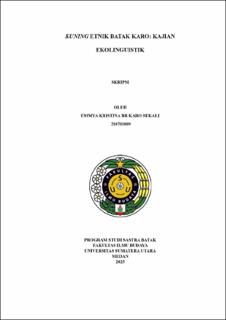Kuning Etnik Batak Karo: Kajian Ekolinguistik
Karo Batak Ethnic Yellow: An Ecological Linguistic Study

Date
2025Author
Sekali, Emmya Kristina Br Karo
Advisor(s)
Herlina
Sinulingga, Jekmen
Metadata
Show full item recordAbstract
This writing aims to describe the types of yellow, flora lexicon contained in yellow, how to make, how to use, and the benefits of yellow, and how the closeness of yellow with ecology in the ethnic Batak Karo. The theory used in this research is the theory of Ecolinguistics by Einer Haugen. The method used in this research is descriptive qualitative research method. The results showed that there are 2 types of ethnic Karo yellow in Guruisngga village, namely yellow mbergeh and yellow melas. There are 26 flora lexicons of yellow mbergeh making materials and 15 flora lexicons of yellow melas making materials. Of the two types of yellow, there are 7 flora lexicon materials that are the same. According to the ecolinguistic analysis, the distance between the lexicon and its ecology is measured in the categories of close, very close, far, and very far. Therefore, there are 25 flora lexicons with a close distance that grow in the field, 4 flora lexicons with a very close distance that grow in the yard, 10 flora lexicons with a far distance that grow in the forest, and 2 flora lexicons with a very far distance that grow in the middle of the forest. The use of the lexicon shows that the closeness of nature to the Karo ethnic group in Gurusingga village is proven to have a close relationship with the parameters of environmental ecology, diversity, and interconnectedness with these plants.
Collections
- Undergraduate Theses [245]
